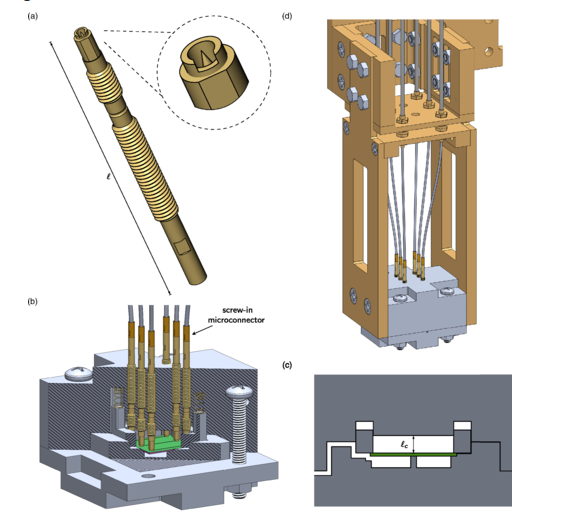“The quantum socket is a wiring method that uses three-dimensional wires based on spring-loaded pins to address individual qubits,” said Jeremy Béjanin, a PhD candidate with IQC and the Department of Physics and Astronomy at Waterloo.
Computer-aided designs of the three-dimensional wire, microwave package, and package holder. (a) A wire of length ℓ=30.5 mm along with a detail of the contact head (inset). (b) Assembled microwave package including six three-dimensional wires, washer, washer springs, and chip (shown in green). The arrow indicates the screw-in microconnector mated to the back end of the wire. Forward hatching indicates the washer cutaway, whereas backward hatching indicates both lid and sample-holder cutaways. (c) Cross section of the microwave package showing the height of the upper cavity
“The technique connects classical electronics with quantum circuits, and is extendable far beyond current limits, from one to possibly a few thousand qubits.”
The quantum socket could be used to realize a “super qubit”—an assembly of a few hundred qubits that works as a single logical qubit but with an error rate 1 order of magnitude lower than that of the individual qubits. The researchers also envision that their socket could be scaled up to connect ∼105∼105 qubits, which could then be used to solve quantum chemistry problems that are hard to tackle with classical computers.
One promising implementation of a scalable quantum computing architecture uses a superconducting qubit, which is similar to the electronic circuits currently found in a classical computer, and is characterized by two states, 0 and 1. Quantum mechanics makes it possible to prepare the qubit in superposition states, meaning that the qubit can be in states 0 and 1 at the same time. To initialize the qubit in the 0 state, superconducting qubits are brought down to temperatures close to -273 degrees Celsius inside a cryostat, or dilution refrigerator.
To control and measure superconducting qubits, the researchers use microwave pulses. The pulses are typically sent from dedicated sources and pulse generators through a network of cables connecting the qubits in the cryostat’s cold environment to the room-temperature electronics. The network of cables required to access the qubits inside the cryostat is a complex infrastructure and until recently has presented a barrier to scaling the quantum computing architecture.
“All wire components in the quantum socket are specifically designed to operate at very low temperatures and perform well in the microwave range required to manipulate the qubits,” said Matteo Mariantoni, a faculty member at IQC and the Department of Physics and Astronomy at Waterloo and senior author on the paper. “We have been able to use it to control superconducting devices, which is one of the many critical steps necessary for the development of extensible quantum computing technologies.”
ABSTRACT -Three-Dimensional Wiring for Extensible Quantum Computing: The Quantum Socket
Quantum computing architectures are on the verge of scalability, a key requirement for the implementation of a universal quantum computer. The next stage in this quest is the realization of quantum error-correction codes, which will mitigate the impact of faulty quantum information on a quantum computer. Architectures with ten or more quantum bits (qubits) have been realized using trapped ions and superconducting circuits. While these implementations are potentially scalable, true scalability will require systems engineering to combine quantum and classical hardware. One technology demanding imminent efforts is the realization of a suitable wiring method for the control and the measurement of a large number of qubits. In this work, we introduce an interconnect solution for solid-state qubits: the quantum socket. The quantum socket fully exploits the third dimension to connect classical electronics to qubits with higher density and better performance than two-dimensional methods based on wire bonding. The quantum socket is based on spring-mounted microwires—the three-dimensional wires—that push directly on a microfabricated chip, making electrical contact. A small wire cross section (approximately 1 mm), nearly nonmagnetic components, and functionality at low temperatures make the quantum socket ideal for operating solid-state qubits. The wires have a coaxial geometry and operate over a frequency range from dc to 8 GHz, with a contact resistance of approximately 150 mΩ, an impedance mismatch of approximately 10 Ω, and minimal cross talk. As a proof of principle, we fabricate and use a quantum socket to measure high-quality superconducting resonators at a temperature of approximately 10 mK. Quantum error-correction codes such as the surface code will largely benefit from the quantum socket, which will make it possible to address qubits located on a two-dimensional lattice. The present implementation of the socket could be readily extended to accommodate a quantum processor with a (10×10)-qubit lattice, which would allow for the realization of a simple quantum memory.
SOURCES – University of Waterloo, Physics, Physical Review Applied

Brian Wang is a Futurist Thought Leader and a popular Science blogger with 1 million readers per month. His blog Nextbigfuture.com is ranked #1 Science News Blog. It covers many disruptive technology and trends including Space, Robotics, Artificial Intelligence, Medicine, Anti-aging Biotechnology, and Nanotechnology.
Known for identifying cutting edge technologies, he is currently a Co-Founder of a startup and fundraiser for high potential early-stage companies. He is the Head of Research for Allocations for deep technology investments and an Angel Investor at Space Angels.
A frequent speaker at corporations, he has been a TEDx speaker, a Singularity University speaker and guest at numerous interviews for radio and podcasts. He is open to public speaking and advising engagements.





